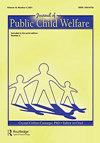一个倾向得分匹配对结果评价的父母计划为双重参与的青少年
IF 0.8
4区 社会学
Q3 SOCIAL WORK
引用次数: 0
摘要
摘要《家庭优先预防和服务法》(FFPSA)使美国儿童福利体系中的服务方式发生了重大政策转变。现在,各州越来越重视并鼓励他们将重点放在防止儿童进入寄养系统和少年司法系统上。此外,FFPSA为这些预防服务制定了严格的证据标准。我们分析了家庭优先育儿计划的青少年司法结果数据,该计划针对2007年至2012年间开始家庭优先的青少年。使用倾向得分匹配配对设计,将该项目中的青少年与同一时间段法院监督的青少年的比较样本进行匹配。我们发现,在项目开始12个月(减少54%)和结束12个月后(减少55%),参加“家庭优先”的年轻人的轻罪和重罪指控明显少于对照组的年轻人。关于身份犯罪和技术犯罪的减少,调查结果喜忧参半。我们的研究结果表明,家庭优先模式可以成为一种有效的干预策略,以减少儿童福利和青少年司法系统中涉及的青少年累犯。本文章由计算机程序翻译,如有差异,请以英文原文为准。
A propensity score matched pair outcome evaluation of a parenting program for dually involved youth
ABSTRACT The Family First Prevention and Services Act (FFPSA) has created a major policy shift in how services are delivered in the US child welfare system. There is now an increased emphasis and incentive for states to focus on preventing children from entering the foster care system and the juvenile justice system. In addition, the FFPSA has created rigorous standards for evidence around these prevention services. We analyzed juvenile justice outcome data for the Family First parenting program for youth who started Families First between 2007 and2012. Youth in the program were matched to a comparison sample of court-supervised youth in the same time period using a propensity score-matched pair design. We found that youth enrolled in Families First had significantly fewer misdemeanor and felony charges than youth in the comparison group 12 months after the start (54% less) and end of the program (55% less). There were mixed findings for reductions in status and technical offenses. Our results suggest that the Families First model can be an effective intervention strategy for reducing recidivism in youth that are involved in both the child welfare and juvenile justice systems.
求助全文
通过发布文献求助,成功后即可免费获取论文全文。
去求助
来源期刊

Journal of Public Child Welfare
SOCIAL WORK-
CiteScore
3.10
自引率
12.50%
发文量
38
期刊介绍:
Decisions made in the practice of child welfare have lifelong effects on children and their entire families which in turn affects every facet of society. To effectively practice in this vital field, social workers, psychologists, counselors, juvenile court judges, attorneys, and other child welfare professionals need to stay informed about the latest findings and important issues in public child welfare. To answer this crucial need, the Journal of Public Child Welfare provides a broad forum for theory-based and applied research in child welfare. Rather than limit itself to primarily private agencies, this essential journal provides the quality research and comprehensive information that child welfare professionals and public agencies need most.
 求助内容:
求助内容: 应助结果提醒方式:
应助结果提醒方式:


